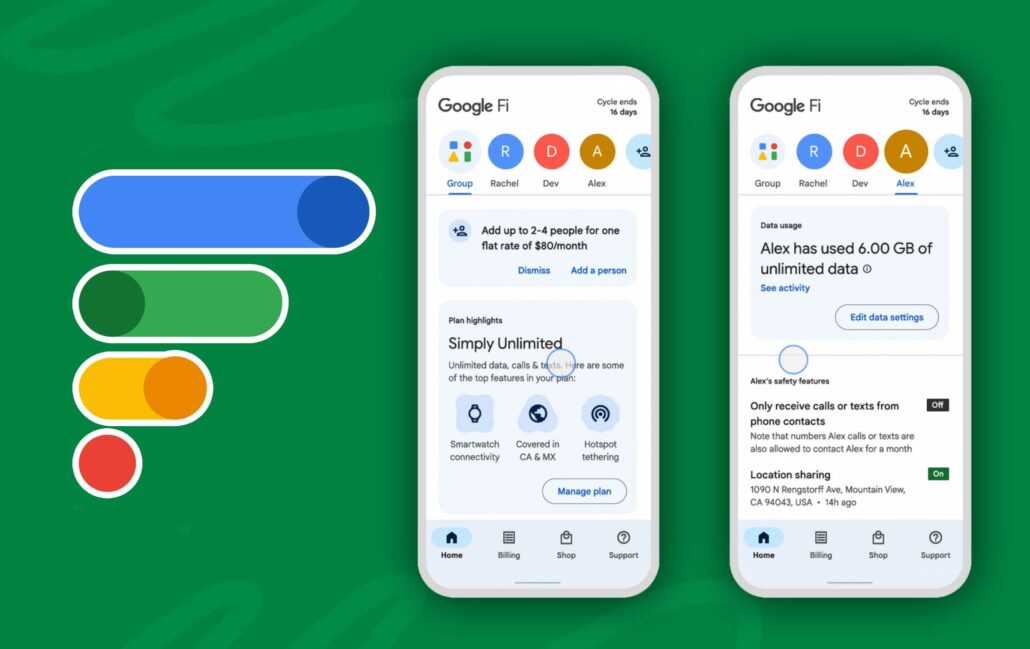Google Fi is a wireless device that operates as a mobile virtual network provider (MVNP), functioning as a phone service within the broader T-Mobile network. Google introduced Project Fi, known as Google Fi, in 2015, aiming to deal with the challenges commonly faced by users of US carriers. When announced, it was accessible to Nexus 6 users but has expanded its compatibility to include both Android and iPhone devices.

However, Google Fi’s primary objective is to provide users with the best cellular and data coverage not only within the United States but also globally. Moreover, the service relies on major 5G and 4G LTE networks, enabling your phone to change between them as users move between areas. Additionally, it utilizes Wi-Fi connectivity for calls and texts whenever Wi-Fi networks are available.
Generally, Google Fi Wireless users offer uninterrupted data connectivity even during high network usage times ensuring connection remains unaffected by network traffic. In addition, it utilizes the W+ network whenever accessible, leveraging Wi-Fi networks to enhance connectivity. However, data consumption during W+ network usage is included in the monthly data allocation. Lastly, if you are considering whether it’s suitable for you, we have provided some insights on its features, pricing, and more.
How Google Fi Works
Google Fi operates by connecting your phone to the most robust accessible network, whether it’s Wi-Fi in certain areas or a 4G LTE network in others. Additionally, its plans include 5G network capabilities, compatible with Android and iPhones. Moreover, if many carrier networks are accessible, Fi will ensure the best connectivity wherever you are.
Also, if Wi-Fi proves to be the right choice, it links your phone to a known high-quality, and secure open Wi-Fi network. In addition, users can link to the W+ network immediately, with the use of Google Fi VPN, providing enhanced data protection on public Wi-Fi networks. Furthermore, users can purchase a phone from Google or bring their device.
However, iPhones are currently in beta testing and require additional setup. Meanwhile, iOS users may not have access to network switching or Wi-Fi calling, but can still utilize other features such as texting, calling, and utilizing 4G LTE.
How Much Does Google Fi Cost
Google Fi simplifies billing without hidden fees. In addition, Fi has presented several new plans, with pricing varying based on the number of lines required. However, here’s a comprehensive breakdown of the costs associated with the minimum single-line Fi plan:
- At $20 per month, it offers unlimited domestic talk and texting, along with unlimited international texting, and cellular coverage spanning over 200 countries.
- You can cover $10 per gigabyte until reaching 6GB ($60) of total usage.
- Moreover, Bill Protection activates, offering data usage free for the remaining billing cycle.
- Once total data usage reaches 15GB, data speeds are lower to 256kbps.
- Lastly, users can choose to cover $10 per gigabyte again to restore full-speed data.
To clarify with the plan, you are only charged for the data you consume, and once you reach a certain data amount, it becomes free for the remainder of the month. Additionally, when traveling, data usage is the same cost as it is when abroad. For a single user, the unlimited data plan costs $50 per month, with a fair usage limit of 35GB.
Moreover, this primary purpose excludes international usage beyond the US, Canada, and Mexico and provides a 5GB hotspot allowance. However, the Unlimited Plus plan is available for $65 per month. It offers a fair usage limit of 50GB, unlimited hotspot tethering, and includes 100GB of Google One cloud storage.
What Network Does Google Fi Use
In the United States, Google Fi utilizes a blend of T-Mobile, Sprint, and U.S. Cellular networks. Additionally, this unique aspect separates it from other services. Phones designed for Google Fi can switch between these networks, determining the one with the strongest signal at any given time.
Which Phones Works With Google Fi
Google Fi is a wireless service that provides coverage through multiple carrier networks. It supports three categories of smartphones. Let’s explore each type and know the best choice for your usage.
Designed For Fi Phones
The selection of phones includes the Samsung Galaxy S22 series, Moto G Power (2022), Samsung Galaxy A53 5G, and Galaxy Z Flip 3. Moreover, all of them are compatible with Fi without any restrictions. Additionally, you can enjoy unrestricted network switching features by navigating to the Google Fi VPN service, and additional perks. However, when these phones are purchased directly from Google Fi, it offers a customized SIM card that is compatible with Fi.
Compatible Fi Phones
Google Fi has expanded its compatibility to include any unlocked Android phone and even iPhones but has some restrictions. Additionally, these devices cannot use Fi’s network switching features, restricting users to the T-Mobile network. Moreover, they do not support Fi’s always-on VPN feature. However, to utilize Fi with such devices, you will need a SIM card, which Google provides free of charge upon online Fi signup.
Pixel Phones
This requires Google’s latest smartphones, like Pixel 8 and 8 Pro, 7, 7a, 6a, and fold models. This implies that it must have an eSIM that connects with Fi. Additionally, this feature enables users to establish a Fi account and connect to its network without the need for a physical SIM card.
However, it’s advisable to use either Google’s smartphones or devices from other manufacturers sold through Fi. This preference from these devices possesses the capability to switch between carriers based on stronger signals in your location.
Major Benefits of Google Fi
Users can benefit from enhanced network coverage provided by Google Fi. It utilizes two carriers T-Mobile and US Cellular, with available Wi-Fi hotspots to deliver a dependable connection wherever feasible. Moreover, you need a smartphone either designed for Fi or compatible with Fi, to unlock Android devices, Pixels, or iPhones.
